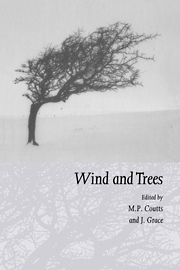Book contents
- Frontmatter
- Contents
- Preface
- List of contributors
- Part I Airflow over topography and in forests
- Part II Mechanics of trees under wind loading
- Part III Tree physiological responses
- Part IV Impacts of wind on forests and ecology
- Part V Risk assessment and management response
- 21 Assessing the risk of wind damage to forests: practice and pitfalls
- 22 Forest wind damage risk assessment for environmental impact studies
- 23 Recommendations for stabilisation of Norway spruce stands based on ecological surveys
- 24 Thinning regime in stands of Norway spruce subjected to snow and wind damage
- 25 A synopsis of windthrow in British Columbia: occurrence, implications, assessement and management
- 26 Wind damage to New Zealand State plantation forests
- 27 The experience of and management strategy adopted by the Selwyn Plantation Board, New Zealand
- Index
23 - Recommendations for stabilisation of Norway spruce stands based on ecological surveys
Published online by Cambridge University Press: 27 October 2009
- Frontmatter
- Contents
- Preface
- List of contributors
- Part I Airflow over topography and in forests
- Part II Mechanics of trees under wind loading
- Part III Tree physiological responses
- Part IV Impacts of wind on forests and ecology
- Part V Risk assessment and management response
- 21 Assessing the risk of wind damage to forests: practice and pitfalls
- 22 Forest wind damage risk assessment for environmental impact studies
- 23 Recommendations for stabilisation of Norway spruce stands based on ecological surveys
- 24 Thinning regime in stands of Norway spruce subjected to snow and wind damage
- 25 A synopsis of windthrow in British Columbia: occurrence, implications, assessement and management
- 26 Wind damage to New Zealand State plantation forests
- 27 The experience of and management strategy adopted by the Selwyn Plantation Board, New Zealand
- Index
Summary
Abstract
Wind stability is considered the major problem in Norway spruce silviculture. Traditional thinning models are characterised by a constancy of thinning intensity throughout the rotation. These models will generally result in low wind stability in spruce stands because they violate the important processes involved in wind stability: (1) The regulation of stem number is usually delayed until pulp wood or timber products can be extracted. This causes a high density of trees and high root competition in young stands, where the branching pattern and the long-term increment capacity of the structural root system are fixed. The production of finer roots during the second half of the rotation is thus strongly inhibited by high stem density in the pre-commercial phase. (2) Stem biomass extraction during the middle and last part of the rotation causes severe loss of ‘anchorage biomass’, as stumps do not contribute to neutralising the ‘storm energy’ transferred to the stand canopy. (3) The removal of trees destroys canopy closure: thinning reduces wind protection by neighbouring trees, because wind gusts penetrate deeper into the canopy, and physical crown contact is reduced. (4) A tree adapts to the very specific wind climate defined by the surrounding trees; therefore a change in wind flow in the canopy caused by removal of neighbouring trees makes it susceptible to damage. The negative effects of these last three factors increase with increasing age and with increasing thinning intensity. Regarding wind stability, a ‘D- to A-degree’ stem number reduction model is recommended.
- Type
- Chapter
- Information
- Wind and Trees , pp. 424 - 435Publisher: Cambridge University PressPrint publication year: 1995
- 14
- Cited by



